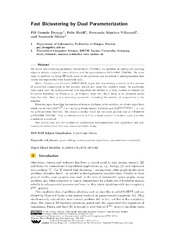| dc.contributor.author | Drange, Pål Grønås | |
| dc.contributor.author | Reidl, Felix | |
| dc.contributor.author | Villaamil, Fernando Sánchez | |
| dc.contributor.author | Sikdar, Somnath | |
| dc.date.accessioned | 2016-05-30T08:06:19Z | |
| dc.date.available | 2016-05-30T08:06:19Z | |
| dc.date.issued | 2015 | |
| dc.identifier.isbn | 978-3-939897-92-7 | |
| dc.identifier.issn | 1868-8969 | en_US |
| dc.identifier.uri | https://hdl.handle.net/1956/12028 | |
| dc.description.abstract | We study two clustering problems, Starforest Editing, the problem of adding and deleting edges to obtain a disjoint union of stars, and the generalization Bicluster Editing. We show that, in addition to being NP-hard, none of the problems can be solved in subexponential time unless the exponential time hypothesis fails. Misra, Panolan, and Saurabh (MFCS 2013) argue that introducing a bound on the number of connected components in the solution should not make the problem easier: In particular, they argue that the subexponential time algorithm for editing to a fixed number of clusters (p-Cluster Editing) by Fomin et al. (J. Comput. Syst. Sci., 80(7) 2014) is an exception rather than the rule. Here, p is a secondary parameter, bounding the number of components in the solution. However, upon bounding the number of stars or bicliques in the solution, we obtain algorithms which run in time O(2^{3*sqrt(pk)} + n + m) for p-Starforest Editing and O(2^{O(p * sqrt(k) * log(pk))} + n + m) for p-Bicluster Editing. We obtain a similar result for the more general case of t-Partite p-Cluster Editing. This is subexponential in k for a fixed number of clusters, since p is then considered a constant. Our results even out the number of multivariate subexponential time algorithms and give reasons to believe that this area warrants further study. | en_US |
| dc.language.iso | eng | eng |
| dc.publisher | Dagstuhl Publishing | en_US |
| dc.rights | Attribution CC BY 3.0 | eng |
| dc.rights.uri | http://creativecommons.org/licenses/by/3.0 | eng |
| dc.subject | graph editing | eng |
| dc.subject | subexponential algorithms | eng |
| dc.subject | Parameterized complexity | eng |
| dc.title | Fast biclustering by dual parameterization | en_US |
| dc.type | Peer reviewed | |
| dc.type | Journal article | |
| dc.date.updated | 2016-03-30T10:15:34Z | |
| dc.description.version | publishedVersion | en_US |
| dc.rights.holder | Copyright Pål Grønås Drange, Felix Reidl, Fernando Sánchez Villaamil, and Somnath Sikdar | en_US |
| dc.identifier.doi | https://doi.org/10.4230/lipics.ipec.2015.402 | |
| dc.identifier.cristin | 1344937 | |
| dc.source.journal | Leibniz International Proceedings in Informatics | |
| dc.source.pagenumber | 402-413 | |
| dc.subject.nsi | VDP::Matematikk og Naturvitenskap: 400 | en_US |
| dc.identifier.citation | Leibniz International Proceedings in Informatics 2015, 43:402-413 | |
| dc.source.volume | 43 | |

